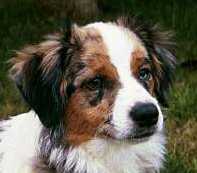"Roof" Search and Rescue Dog in Training

On September 11th, 2001 - the day our hearts turned east, I stopped
contemplating an agility sport career for the very agile Roof, and decided
to pursue a lifelong interest in Search and Rescue dogs. Roof, my
Miniature Australian Shepherd, thought it would be fun to go someplace
where all the humans had treats and toys in their pockets.
It took a bit of searching just to find a training group. It seems
that in populated areas, there is no shortage of people expressing
an interest in Search and Rescue. A handler could spend all his time
just answering inquiries from new persons and never get any training
in for himself. Since Search and Rescue (SAR) is largely a volunteer
group, there is no administrative staff just to handle inquiries.
I searched the internet and found NASAR, the National Association for
Search and Rescue and followed the links to my area. An area
representative finally answered my email, but I was already hooked
up with my group, through a friend of a friend of a friend who knew
someone that did this sort of thing. There are actually lots of
different units with different philosophies, so a dog handler should
be able to find a compatible group.
Anyway, we finally found where a friendly group was practicing. Since
these meetings take place in wilderness type areas, just finding the
site is a challenge. I barely passed that test, and we arrived on
time. Alameda County Search and Rescue has a very friendly and
skilled membership. "Denise" and "Carolyn" (their real names are
used to protect the innocent) are the puppy and newbee wranglers.
They are a national treasure with their ability to guide the training
of handlers and dogs. They both train full-sized Australian Shepherds
, but Roof is the first mini in this group. Two more have come for a
visit, so the miniature Australian Shepherd may make major inroads in
this arena.
Before we even attended a practice, we were warned that volunteering
for Search and Rescue is expensive and time consuming. Handlers can
spend thousands of dollars on supplies and travel expenses, with only
a charitable deduction on your taxes to offset the costs. Once a team
is certified, they can expect emergency calls at all hours of the
night or in the middle of your day job. Having understanding employer
s is a must! We remained enthusiastic and eager, even after we
encountered prejudice against the smaller size of a mini Aussie.
Many people told that a mini is too small to do a big dog's job.
They worry that it is more dangerous in the wilderness for a smaller
dog. However, I believe that the small dog learns survival skills
that do not include using large size to fight off attacks. I'm sure
Roof and I will run really fast away from danger!
On our first night, we met and watched a lot of "mission-ready" dogs
"work a problem" and we got to do our first training exercise. We
did a handler runaway. While someone gently blocked Roof's forward
progress, I ran a short distance away - all the while squealing and
waving my arms. At about 20 feet away, I squatted down in plain sight
, and "hid". The restrainer let Roof go with a "search" cue, and Roof
expertly ran to his handler to enjoy his treats and praise. Before too
long, the handler restrains the dog, and a victim runs away from the
puppy and hides. Roof really loves finding people. It is legal to
lick the victim, climb in their laps and get all the petting and
praise and treats a puppy can handle.
Since wilderness searches can result in a dog finding a victim
completely out of sight of the handler, the dog needs to learn to go
get the handler and bring them back to the victim. Therefore, after
a few months of runaways in all kinds of terrain, we began to add a
"refind". The refind training consists of learning to run back to the
handler, give some sort of signal to indicate a find, and then lead
the handler back to the victim.
Some dogs will indicate a find by sitting, barking, jumping, or
carrying a specified object in their mouth. Roof tells me he is
alerting, by spinning. The trainers tell me they know of no one in the history of Search and Rescue who had chosen a spin alert. Well, it seems to work and we enjoy it. I've chosen
not to listen to the handler that wondered if Roof would get dizzy
and not be able to tell which way the victim was hidden.
Because of the remarkable aptitude of Roof and myself, Roof was
finally allowed to wear the SAR shabrack (jacket). I never told
Roof that everyone else in the beginner group got theirs at the
same time. Seriously, Roof, is really impressing folks with his enthusiasm and drive.
He loves to find people so much, he doesn't always remember to claim his treat reward.
Finding the people is great fun in itself. Of course, standard
Aussies are also getting credit, because many folks think he is an
Aussie puppy. He honors all his ancestors by his puppy training success.


Bryngyld home page


